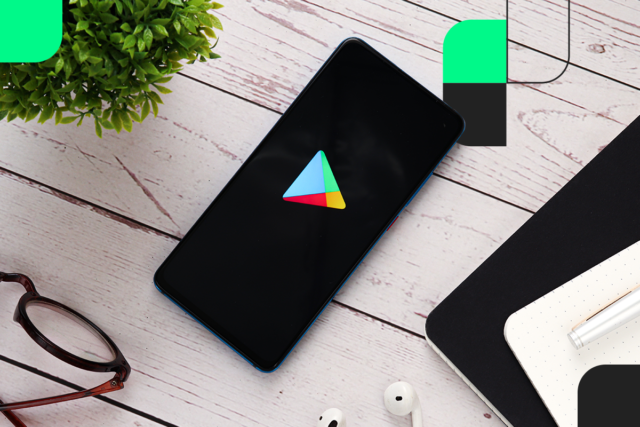Optimizing your mobile app for the Google Play Store is essential to improve visibility, attract downloads, and enhance user engagement. With millions of apps available, standing out requires a strategic approach to App Store Optimization (ASO). Here are some best practices to help you optimize your mobile app effectively.

Table of Contents
Toggle1. Conduct Keyword Research
Keyword research is fundamental for optimizing your app’s visibility in the Play Store.
- Identify Relevant Keywords: Use tools like Google Keyword Planner, App Annie, or Sensor Tower to find keywords relevant to your app’s features, functionality, and target audience.
- Analyze Competitors: Review competitor apps in your category to identify the keywords they are using and their ranking. This can provide insight into potential keywords you might have overlooked.
2. Optimize Your App Title and Description
The app title and description play a crucial role in both search rankings and user conversion.
- App Title: Choose a clear and concise title that includes your primary keyword. Keep it within 30 characters to ensure it’s fully visible on various devices.
- App Description: Write a compelling app description that includes relevant keywords, but avoid keyword stuffing. Focus on:
- Short Description: A brief overview (up to 80 characters) highlighting the app’s key features.
- Full Description: An informative and engaging description (up to 4,000 characters) that elaborates on the app’s benefits, features, and unique selling points. Use bullet points for readability.
3. Utilize App Icons and Screenshots Effectively
Visual elements significantly influence user decision-making.
- App Icon: Design a simple yet memorable icon that reflects your app’s purpose. A visually appealing icon can improve click-through rates.
- Screenshots: Include high-quality screenshots showcasing your app’s key features. Use captions to explain each screenshot’s significance and how it enhances the user experience.
- Feature Graphic: Create an eye-catching feature graphic (1024×500 pixels) that represents your app and grabs attention on the Play Store.
4. Leverage Video Marketing
A promotional video can effectively showcase your app’s functionality and benefits.
- Create an Engaging Video: Develop a short (30 seconds to 1 minute) video that highlights your app’s features, user interface, and unique value proposition.
- Use the Right Format: Upload the video to YouTube and link it in your app’s Play Store listing. Make sure it’s engaging and showcases real use cases.
5. Encourage User Reviews and Ratings
User reviews and ratings are vital for your app’s credibility and ranking.
- Prompt Users for Reviews: After a positive experience, prompt users to leave a review. Use in-app messaging to request feedback at appropriate times, such as after completing a task or achieving a milestone.
- Respond to Reviews: Actively engage with users by responding to reviews, addressing concerns, and thanking them for their feedback. This demonstrates commitment to customer satisfaction.
6. Implement Localized Content
If your app targets users in different countries, localization can significantly improve user acquisition.
- Translate Your App: Localize your app title, description, and keywords into the target language. Use culturally relevant images and content to connect with local users.
- Adapt to Local Trends: Research and integrate local trends or preferences into your app to enhance user engagement and relevance.
7. Monitor and Analyze Performance Metrics
Continuous monitoring and analysis of your app’s performance is key to identifying areas for improvement.
- Use Google Play Console: Track metrics such as downloads, user retention, and conversion rates. Analyze which keywords are driving traffic and which features users engage with most.
- A/B Testing: Experiment with different app titles, descriptions, and visuals to identify the most effective combinations. Use the insights gained from testing to optimize your listing further.
8. Regularly Update Your App
Keeping your app fresh and up-to-date helps retain users and attract new ones.
- Release Updates: Regularly update your app to fix bugs, introduce new features, and improve user experience. Highlight these updates in the app description to inform users of changes.
- Engage with User Feedback: Use user reviews and feedback to guide your updates. Address common issues or requests to enhance user satisfaction.
9. Optimize for Technical Aspects
Ensure that your app functions smoothly and adheres to Google’s guidelines.
- Performance Optimization: Test your app for speed, responsiveness, and crash issues. A well-functioning app improves user satisfaction and retention.
- Adhere to Google’s Policies: Familiarize yourself with Google Play’s developer policies to avoid potential penalties or removal from the store.
10. Promote Your App Externally
Enhance your app’s visibility beyond the Play Store through various marketing strategies.
- Leverage Social Media: Use platforms like Facebook, Instagram, and Twitter to promote your app, share updates, and engage with potential users.
- Collaborate with Influencers: Partner with influencers in your app’s niche to reach a wider audience and drive downloads.
- Create a Dedicated Website: Develop a website or landing page for your app to provide additional information, gather leads, and drive downloads.
Conclusion
Optimizing your mobile app for the Google Play Store is an ongoing process that requires strategic planning, continuous monitoring, and adaptation. By following these best practices, you can enhance your app’s visibility, improve user engagement, and ultimately drive more downloads. Remember that user experience is at the core of your app’s success—focus on providing value, addressing user needs, and building a community around your app to foster loyalty and growth.
